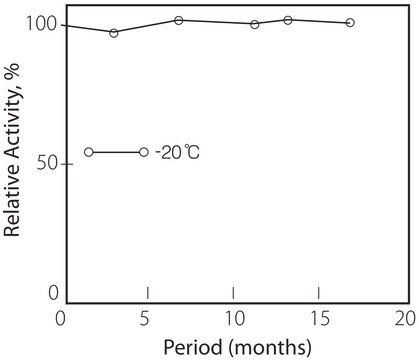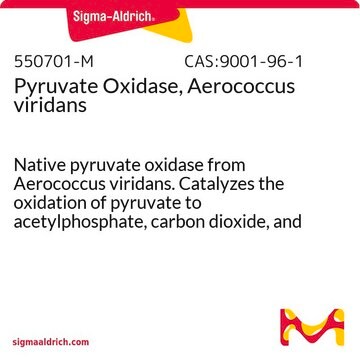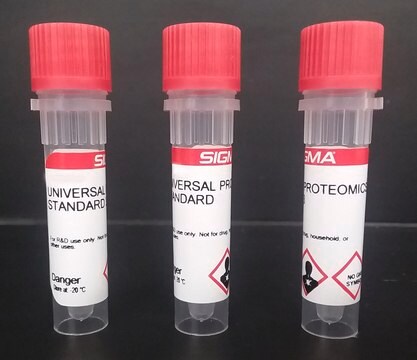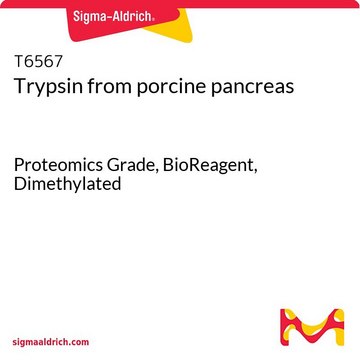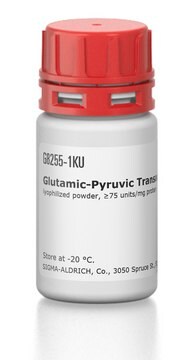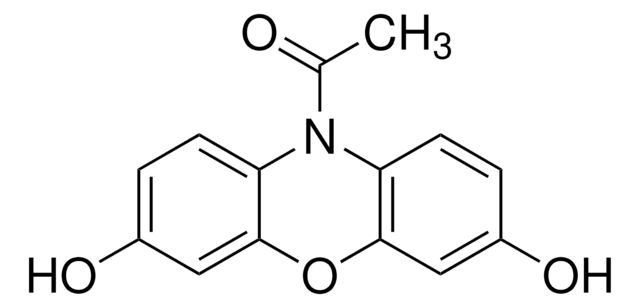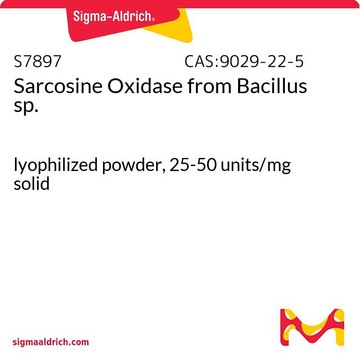P4105
Pyruvate Oxidase from Aerococcus sp.
lyophilized powder, ≥35 units/mg protein (biuret)
Sinonimo/i:
Pyruvate: oxygen oxidoreductase (phosphorylating)
Autenticatiper visualizzare i prezzi riservati alla tua organizzazione & contrattuali
About This Item
Prodotti consigliati
Origine biologica
bacterial (Aerococcus spp.)
Livello qualitativo
Stato
lyophilized powder
Attività specifica
≥35 units/mg protein (biuret)
Temperatura di conservazione
−20°C
Applicazioni
Pyruvate Oxidase (PoxB) converts pyruvate directly to acetate and CO2. It is used to study pyruvate metabolism. It is used to study aerobic metabolism of bacterium, such as Lactobacillus plantarumand Streptococcus pneumoniae.
Pyruvate Oxidase from Aerococcus sp. has been used in the amplex Red-based fluorescence assay for pyruvate. It is suitable for use in the preparation of biosensor for determination of thiamine (vitamin B1), and as a component in the constant part of the multi-enzyme biocatalytic cascade for the determination of biomarkers for traumatic brain injury (TBI) and soft tissue injury (STI).
Azioni biochim/fisiol
Pyruvate Oxidase consists of four subunits with identical molecular weights. PoxB reacts with certain aldehydes and phosphate can be replaced by arsenate. Oxygen as well as several artificial compounds can function as electron acceptors. Pyruvate Oxidase is activated by phospholipids as well as monomeric and micellar amphiphiles.
Pyruvate Oxidase oxidises pyruvate to form acetate, hydrogen peroxide and carbon dioxide. Pyruvate oxidase requires flavin adenine dinucleotide (FAD), thiamine pyrophosphate (TPP) and magnesium as cofactors for its catalytic activity. Thiamine activates pyruvate oxidase activity.
Definizione di unità
One unit will produce 1.0 μmole of H2O2 per min during the conversion of pyruvate and phosphate to acetylphosphate and CO2 at pH 6.7 at 37 °C.
Stato fisico
Lyophilized powder containing buffer salt and sugar
Avvertenze
Danger
Indicazioni di pericolo
Consigli di prudenza
Classi di pericolo
Resp. Sens. 1
Codice della classe di stoccaggio
11 - Combustible Solids
Classe di pericolosità dell'acqua (WGK)
WGK 3
Punto d’infiammabilità (°F)
Not applicable
Punto d’infiammabilità (°C)
Not applicable
Dispositivi di protezione individuale
Eyeshields, Gloves, type N95 (US)
Scegli una delle versioni più recenti:
Possiedi già questo prodotto?
I documenti relativi ai prodotti acquistati recentemente sono disponibili nell’Archivio dei documenti.
I clienti hanno visto anche
Hiroaki Taniai et al.
Journal of bacteriology, 190(10), 3572-3579 (2008-03-18)
Streptococcus pneumoniae was shown to possess lactate oxidase in addition to well-documented pyruvate oxidase. The activities of both H(2)O(2)-forming oxidases in wild-type cultures were detectable even in the early exponential phase of growth and attained the highest levels in the
B Sedewitz et al.
Journal of bacteriology, 160(1), 462-465 (1984-10-01)
Under aerobic growth conditions Lactobacillus plantarum produced acetic acid in addition to lactic acid. It was found that lactic acid was predominantly produced at first, and then when the carbohydrate was nearly exhausted, lactic acid was metabolized further to acetic
Multi-enzyme logic network architectures for assessing injuries: digital processing of biomarkers
Halamek J, et al.
Molecular Biosystems, 6(12), 2554-2560 (2010)
B Sedewitz et al.
Journal of bacteriology, 160(1), 273-278 (1984-10-01)
Pyruvate oxidase (EC 1.2.3.3) was isolated and characterized from Lactobacillus plantarum. The enzyme catalyzes the oxidative decarboxylation of pyruvate in the presence of phosphate and oxygen, yielding acetyl phosphate, carbon dioxide, and hydrogen peroxide. This pyruvate oxidase is a flavoprotein
A sensitive fluorimetric assay for pyruvate
Zhu A, et al.
Analytical Biochemistry, 396(1), 146-151 (2010)
Il team dei nostri ricercatori vanta grande esperienza in tutte le aree della ricerca quali Life Science, scienza dei materiali, sintesi chimica, cromatografia, discipline analitiche, ecc..
Contatta l'Assistenza Tecnica.